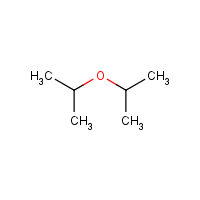Isopropyl ether
Agent Name
Isopropyl ether
Alternative Name
Diisopropyl ether
CAS Number
108-20-3
Formula
C6-H14-O
Major Category
Solvents

Synonyms
2,2'-Oxybis-propane; 2-Isopropoxypropane; Bis(isopropyl) ether; Diisopropyl ether; Diisopropyl oxide; Ether isopropylique [French]; Ether, isopropyl; Izopropylowy eter [Polish]; Propane, 2,2'-oxybis-; [ChemIDplus] UN1159
Category
Ethers (<C12)
Description
Colorless liquid with a sharp, sweet, ether-like odor; [NIOSH]
Sources/Uses
Used as a solvent for resins, waxes, oils, dyes, and surface coatings; [ACGIH]
Comments
The odor is "more irritating and less pleasant than that of ethyl ether." [ACGIH] A skin, eye, and respiratory tract irritant; Inhalation of high concentrations can cause CNS depression; [ICSC]
Biomedical References
Exposure Assessment
Skin Designation (ACGIH)
Insufficient data
TLV (ACGIH)
20 ppm
STEL (ACGIH)
310 ppm
PEL (OSHA)
500 ppm
MAK
200 ppm
IDLH (NIOSH)
1400 ppm
Excerpts from Documentation for IDLHs
Volunteers exposed to 800 ppm for 5 minutes reported irritation of the eyes and nose [Silverman et al. 1946].
Vapor Pressure
149 mm Hg
Odor Threshold Low
0.01 ppm
Odor Threshold High
0.05 ppm
Lethal Concentration
LC50 (rat) = 162,000 mg/m3
Explanatory Notes
IDLH = 10% LEL; Detection odor threshold from AIHA (mean = 0.017 ppm); Flash point = -28 deg C; VP from HSDB;
NFPA
may ignite at ambient temp
Adverse Effects
Neurotoxin
Acute solvent syndrome
ACGIH Carcinogen
Not Classifiable
Diseases, Processes, and Activities Linked to This Agent
Diseases
Occupational diseases associated with exposure to this agent:
Processes
Industrial Processes with risk of exposure: